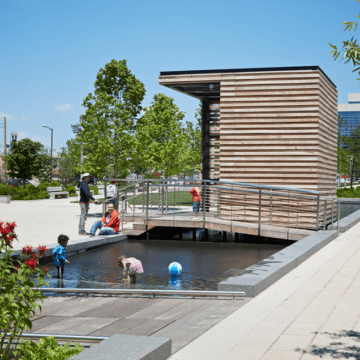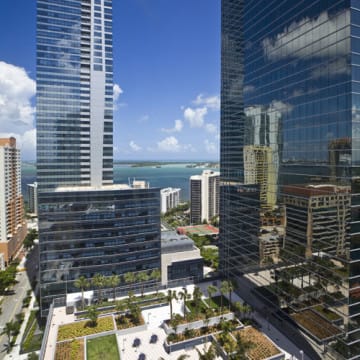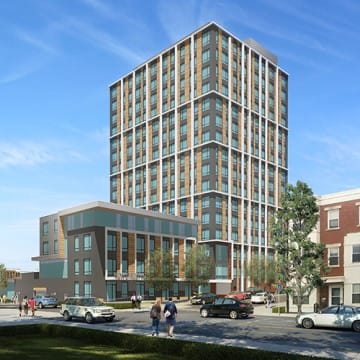Cook Park
Rodney Cook Sr. Peace Park (“Cook Park”) at Historic Vine City is a 16-acre park in Atlanta, Georgia, that was uniquely designed to alleviate flooding and address the severe storm damage that occurred in the neighborhood in 2002. Recognizing the neighborhood’s important history from the civil rights era, the park is a vibrant open space that represents a shared vision between residents and local leaders to restore an unused space and reinvigorate the neighborhood.
Context
In its heyday, Vine City was a center for activism and leadership during the civil rights movement of the 1950s and 1960s. However, the neighborhood declined after decades of disinvestment, poverty, crime, and racist land use policies. By the early 2000s, the neighborhood was one of Atlanta’s most distressed communities. Topography also is a major challenge for Vine City, which lies on low ground within the Proctor Creek watershed and is therefore prone to flooding during heavy rains. In September 2002, flash flooding from Tropical Storm Hanna overwhelmed the neighborhood’s sewer system, inundating dozens of homes, and displacing hundreds of residents. With most houses damaged beyond repair, city leaders decided that both the cost to rebuild and the risk of future flooding were too great. The city of Atlanta purchased 60 properties and relocated residents, but the land was undeveloped for more than a decade.
In the years following the flood, a coordinated partnership among Vine City residents, the city of Atlanta, and Trust for Public Land created a vision for the site that would address flood risk and provide much-needed green space and community amenities. In 2010, the city of Atlanta developed a park master plan for the Vine City and English Avenue neighborhood. The resulting community engagement process included dozens of meetings, events, and in-depth conversations with residents to identify the neighborhood’s needs and priorities over the course of the multiyear planning process. The final design of the park integrated innovative stormwater retention facilities alongside a playground, splash pad, sport courts, and walking paths.
The park pays homage to the neighborhood’s important history with statues of notable peacemakers including the late United States Representative John Lewis, D-Atlanta, and Martin Luther King, Jr., who was a resident of Vine City in the 1960s. In 2018, a dedicated effort to engage neighborhood youth in the park’s redevelopment resulted in two custom climbing boulder installations, made possible by a partnership with The North Face outdoor apparel and gear company. Also, the VF Foundation funded two murals designed by local public artists in concert with the neighborhood to honor the rich musical roots and neighborhood leaders that made Vine City what it is today. Trust for Public Land and city officials worked hard to center residents’ voices in the planning process to ensure that the park met community needs and honored its history.
After more than eleven years in the making, Rodney Cook Sr. Peace Park opened to the public in July 2021 and has quickly become an essential piece of the community.
“Rodney Cook Park is located at the low point of Vine City, so all water flows to where the park is,” said George Dusenbury, Georgia state director for the Trust for Public Land. “We have worked with the city to repurpose this land into a park that floods so that the surrounding communities do not.”
Climate Resilience Strategies
The centerpiece detention pond and water features can capture and store up to 10 million gallons of stormwater during intense rainstorms. Surrounding the pond are constructed wetlands, native stormwater plantings, and rain gardens that further absorb and filter water to minimize flood risk to Vine City residents and improve water quality.
The engineering team also created a stormwater strategy that extends beyond the park to the full 150-acre Proctor Creek / North Avenue watershed, representing thousands of westside residents who benefit from a better stormwater management system. Now the park’s green infrastructure captures water from the broader drainage area to reduce peak loads that would normally strain the sewer system.
In addition to mitigating the negative impacts of stormwater, the park provides relief from the urban heat island effect with green space, native plants, and shady trees. Cook Park’s stormwater infrastructure and recreational amenities combine to create a unique place that contributes to a healthier and more resilient community.
Value Proposition
- Added amenity: The dual-purpose park has helped the city of Atlanta achieve key goals for stormwater management and new green space development. Within days of the park’s opening, neighborhood residents were taking full advantage of the new walking paths, splash pad, amphitheater, basketball court, and great lawn. No longer a vacant parcel, the park today hums with activity and offers a scenic destination to be enjoyed by all.
- Avoided losses: Although at the time of this writing there have not been any significant flooding events to test the park’s green infrastructure to its full capacity, the neighborhood is well prepared for future heavy rainstorms. Rainstorms have been increasing in their number and severity due to climate change, with trends expected to continue over the coming decades. The last time the city saw significant flooding was in 2009 and resulted in $500 million in property damage with more than 20,000 homes, businesses and other buildings significantly impacted. The city’s sizable investment in Cook Park and the neighborhood’s stormwater infrastructure will easily pay for itself in avoided property damage after only a few intense storms.
- Enhanced property value: The park is also contributing to the revival of Vine City, which has for many years experienced higher rates of unemployment and crime compared with other Atlanta neighborhoods. The average price for a single-family home in Vine City rose from around $14,000 in 2011 to $255,000 in 2021. In comparison, the average price of a home in other Atlanta neighborhoods increased from $307,000 to $580,000. Given the sizable public investment in the park, the city and neighborhood groups acknowledge that displacement and gentrification could occur in Vine City. Nonprofits and affordable housing developers are acquiring property as quickly as possible to mitigate displacement and preserve the affordability of the area. Other organizations, like the Westside Future Fund, are helping homeowners pay their property tax increases through mortgage assistance programs so that longtime residents can stay in the neighborhood.
Lessons Learned
- An innovative partnership between the city of Atlanta and Trust for Public Land allowed the project to meet multiple community needs. Atlanta’s Department of Watershed Management provided funding for Cook Park’s network of green infrastructure designed to reduce flooding in the historic neighborhood. Trust for Public Land provided philanthropic support that funded the project’s community engagement, design, and construction of multiuse sports courts, a splash pad, a playground, walking trails, and a collection of other park amenities. The combined effort resulted in a destination that delivers a host of environmental and community benefits to the neighborhood.
- Stormwater management inspired local community engagement and conservation. During the planning phase, the number-one desire from the community was to have a park that reduced the risk of future flooding. The design team developed educational signage about the park’s stormwater management functions, helping the community better understand the purpose of each of the design elements and the role they play in mitigating flood risk.
- The most important aspect of Cook Park’s realization was community involvement throughout all stages of planning, design, and construction. The community engagement process began with participatory design at the outset of the project when residents shared and shaped what they wanted to see in the new community open space. Feedback provided by neighborhood residents in surveys and at dozens of public meetings informed the design team about the park amenities most desired by residents. Even after construction started, unexpected opportunities like climbing boulders and murals allowed for community stakeholders to further refine unique elements of the park. In addition, the project contractor employed neighborhood residents trained in basic construction skills to build Cook Park, further creating a sense of pride and ownership by the community long after construction was complete. Intentional community engagement throughout planning and construction generated anticipation toward the park’s eventual ribbon cutting and created a groundswell of support, ownership, and stewardship of the dynamic public green space. By building relationships early on, community members became invested in the park’s success and excited to protect the park for future generations.


